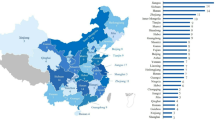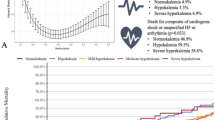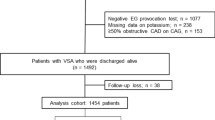Abstract
Hydrochlorothiazide is the most common thiazide diuretic used for hypertension in the US. Yet, hypokalaemia is a well-recognised adverse effect. To evaluate the prevalence and factors associated with hypokalaemia (serum potassium < 3.5 mmol/L) among hydrochlorothiazide users, we included US adults aged ≥20 years in the 1999–2018 National Health and Nutrition Examination Survey. Participants were categorised according to the use of hydrochlorothiazide and other antihypertensive agents. Factors associated with hypokalaemia, including demographics and prescription patterns (monotherapy vs single-pill fixed-dose combination vs polytherapy) were studied using multivariable logistic regression. Hypokalaemia was present in 12.6% of the hydrochlorothiazide users, equivalent to ~2.0 million US adults. Women (adjusted OR, 2.22; 95% CI, 1.74–2.83), non-Hispanic blacks (adjusted OR, 1.65; 95% CI, 1.31–2.08), underweight (adjusted OR, 4.33; 95% CI, 1.34–13.95), and participants taking hydrochlorothiazide for five years or more (adjusted OR, 1.47; 95% CI, 1.06–2.04) had a higher risk of hypokalaemia. Compared to monotherapy, fixed-dose combination therapy (adjusted OR, 0.32; 95% CI, 0.21–0.48) was associated with the lowest risk. Among those taking potassium supplements, hypokalaemia was found in 27.2% of participants on monotherapy and 17.9% on polytherapy. The prevalence of hypokalaemia among hydrochlorothiazide users was considerable, even among participants who also took potassium supplements. Women, ethnic minorities, underweight, monotherapy, and participants with long-term therapy are more likely to have hypokalaemia. Regular monitoring of potassium and combination with potassium-sparing drugs are needed.
This is a preview of subscription content, access via your institution
Access options
Subscribe to this journal
Receive 12 digital issues and online access to articles
$119.00 per year
only $9.92 per issue
Buy this article
- Purchase on SpringerLink
- Instant access to full article PDF
Prices may be subject to local taxes which are calculated during checkout


Similar content being viewed by others
Data availability
Data used in this study are available from the published data of the NHANES database (https://www.cdc.gov/nchs/nhanes/index.htm).
References
The ALLHAT Officers and Coordinators for the ALLHAT Collaborative Research Group. Major outcomes in high-risk hypertensive patients randomized to angiotensin-converting enzyme inhibitor or calcium channel blocker vs diuretic: The Antihypertensive and Lipid-Lowering Treatment to Prevent Heart Attack Trial (ALLHAT). JAMA. 2002;288:2981–97.
Chobanian AV, Bakris GL, Black HR, Cushman WC, Green LA, Izzo JL Jr, et al. The Seventh Report of the Joint National Committee on Prevention, Detection, Evaluation, and Treatment of High Blood Pressure: the JNC 7 report. JAMA. 2003;289:2560–72.
Michael E, Ernst MM. Use of diuretics in patients with hypertension. N Engl J Med. 2009;361:2153–64.
Franse LV, Pahor M, Di Bari M, Somes GW, Cushman WC, Applegate WB. Hypokalemia associated with diuretic use and cardiovascular events in the Systolic Hypertension in the Elderly Program. Hypertension. 2000;35:1025–30.
Schnaper HW, Freis ED, Friedman RG, Garland WT, Hall WD, Hollifield J, et al. Potassium restoration in hypertensive patients made hypokalemic by hydrochlorothiazide. Arch Intern Med. 1989;149:2677–81.
Alfonzo AV, Isles C, Geddes C, Deighan C. Potassium disorders-clinical spectrum and emergency management. Resuscitation. 2006;70:10–25.
Kardalas E, Paschou SA, Anagnostis P, Muscogiuri G, Siasos G, Vryonidou A. Hypokalemia: a clinical update. Endocr Connect. 2018;7:R135–r146.
Roush GC, Ernst ME, Kostis JB, Kaur R, Sica DA. Not just chlorthalidone: evidence-based, single tablet, diuretic alternatives to hydrochlorothiazide for hypertension. Curr Hypertens Rep. 2015;17:540.
The ClinCalc DrugStats Database. (2021). Hydrochlorothiazide, drug usage statistics, United States, 2013–2019. https://clincalc.com/DrugStats/Drugs/Hydrochlorothiazide. Accessed Sep 2021.
Unger T, Borghi C, Charchar F, Khan NA, Poulter NR, Prabhakaran D, et al. 2020 International Society of Hypertension Global Hypertension Practice Guidelines. Hypertension. 2020;75:1334–57.
Suchard MA, Schuemie MJ, Krumholz HM, You SC, Chen R, Pratt N, et al. Comprehensive comparative effectiveness and safety of first-line antihypertensive drug classes: a systematic, multinational, large-scale analysis. Lancet. 2019;394:1816–26.
de Cates AN, Farr MR, Wright N, Jarvis MC, Rees K, Ebrahim S, et al. Fixed-dose combination therapy for the prevention of cardiovascular disease. Cochrane Database Syst Rev. 2014;4:CD009868.
Roush GC, Ernst ME, Kostis JB, Tandon S, Sica DA. Head-to-head comparisons of hydrochlorothiazide with indapamide and chlorthalidone: antihypertensive and metabolic effects. Hypertension. 2015;65:1041–6.
National Center for Health Statistics, Centers for Disease Control and Prevention. (2020). NHANES response rates and population totals. https://wwwn.cdc.gov/nchs/nhanes/ResponseRates.aspx#response-rates. Accessed Aug 2021.
National Center for Health Statistics, Centers for Disease Control and Prevention. (2020). NHANES questionnaires, datasets, and related documentation. https://wwwn.cdc.gov/nchs/nhanes/default.aspx. Accessed Aug 2021.
Krogager ML, Kragholm K, Thomassen JQ, Søgaard P, Lewis BS, Wassmann S, et al. Update on management of hypokalaemia and goals for the lower potassium level in patients with cardiovascular disease: a review in collaboration with the European Society of Cardiology Working Group on Cardiovascular Pharmacotherapy. Eur Heart J Cardiovasc Pharmacother. 2021;7:557–67.
Palmer BF, Carrero JJ, Clegg DJ, Colbert GB, Emmett M, Fishbane S, et al. Clinical management of hyperkalemia. Mayo Clin Proc. 2021;96:744–62.
National Health and Nutrition Examination Survey. (2020). 2017-2018 data documentation, codebook, and frequencies. https://wwwn.cdc.gov/Nchs/Nhanes/2017-8/BIOPRO_J.htm#Analytic_Notes. Accessed Aug 2021.
Levey AS, Stevens LA, Schmid CH, Zhang YL, Castro AF 3rd, Feldman HI, et al. A new equation to estimate glomerular filtration rate. Ann Intern Med. 2009;150:604–12.
Gennari FJ. Hypokalemia. N Engl J Med. 1998;339:451–8.
Nilsson E, Gasparini A, Ärnlöv J, Xu H, Henriksson KM, Coresh J, et al. Incidence and determinants of hyperkalemia and hypokalemia in a large healthcare system. Int J Cardiol. 2017;245:277–84.
Thoenes M, Neuberger HR, Volpe M, Khan BV, Kirch W, Böhm M. Antihypertensive drug therapy and blood pressure control in men and women: an international perspective. J Hum Hypertens. 2010;24:336–44.
Rydberg DM, Mejyr S, Loikas D, Schenck-Gustafsson K, von Euler M, Malmström RE. Sex differences in spontaneous reports on adverse drug events for common antihypertensive drugs. Eur J Clin Pharm. 2018;74:1165–73.
Sun H, Weaver CM. Rising trend of hypokalemia prevalence in the US population and possible food causes. J Am Coll Nutr. 2021;40:273–9.
Chen Y, Sang Y, Ballew SH, Tin A, Chang AR, Matsushita K, et al. Race, serum potassium, and associations with ESRD and mortality. Am J Kidney Dis. 2017;70:244–51.
Kovesdy CP, Appel LJ, Grams ME, Gutekunst L, McCullough PA, Palmer BF, et al. Potassium homeostasis in health and disease: a scientific workshop cosponsored by the National Kidney Foundation and the American Society of Hypertension. J Am Soc Hypertens. 2017;11:783–800.
Mariosa LSS, Ribeiro‐Filho FF, Batista MC, Hirota AH, Borges RL, Ribeiro AB, et al. Abdominal obesity is associated with potassium depletion and changes in glucose homeostasis during diuretic therapy. J Clin Hypertens. 2008;10:443–9.
Palmer BF. Regulation of potassium homeostasis. Clin J Am Soc Nephrol. 2015;10:1050–60.
Gupta AK, Arshad S, Poulter NR. Compliance, safety, and effectiveness of fixed-dose combinations of antihypertensive agents: a meta-analysis. Hypertension. 2010;55:399–407.
Clayton JA, Rodgers S, Blakey J, Avery A, Hall IP. Thiazide diuretic prescription and electrolyte abnormalities in primary care. Br J Clin Pharm. 2006;61:87–95.
Chang AR, Sang Y, Leddy J, Yahya T, Kirchner HL, Inker LA, et al. Antihypertensive medications and the prevalence of hyperkalemia in a large health system. Hypertension. 2016;67:1181–8.
Krogager ML, Torp-Pedersen C, Mortensen RN, Kober L, Gislason G, Sogaard P, et al. Short-term mortality risk of serum potassium levels in hypertension: a retrospective analysis of nationwide registry data. Eur Heart J. 2017;38:104–12.
Cohn JN, Kowey PR, Whelton PK, Prisant LM. New guidelines for potassium replacement in clinical practice: a contemporary review by the National Council on Potassium in Clinical Practice. Arch Intern Med. 2000;160:2429–36.
Kaplan NM, Carnegie A, Raskin P, Heller JA, Simmons M. Potassium supplementation in hypertensive patients with diuretic-induced hypokalemia. N Engl J Med. 1985;312:746–9.
Author information
Authors and Affiliations
Contributions
ZL designed the study and analysed the data. ZL and HLL drafted the manuscript. HLL, MFT and BMYC made review comments. All authors critically revised the manuscript and had responsibility for the final content.
Corresponding author
Ethics declarations
Competing interests
The authors declare no competing interests.
Ethics approval
NHANES protocol was approved by the NCHS Research Ethics Review Board and all participants gave informed consent prior to conducting NHANES.
Additional information
Publisher’s note Springer Nature remains neutral with regard to jurisdictional claims in published maps and institutional affiliations.
Supplementary information
Rights and permissions
About this article
Cite this article
Lin, Z., Li, H.L., Tsoi, M.F. et al. Hypokalaemia associated with hydrochlorothiazide used in the treatment of hypertension in NHANES 1999–2018. J Hum Hypertens 37, 354–362 (2023). https://doi.org/10.1038/s41371-022-00704-x
Received:
Revised:
Accepted:
Published:
Issue date:
DOI: https://doi.org/10.1038/s41371-022-00704-x



